Metal roof cladding has gained significant popularity in construction, thanks to its durability, energy efficiency, and aesthetic appeal. Whether you’re a homeowner looking for a modern upgrade or a contractor seeking robust materials for your next project, understanding metal roof cladding is essential. But with so many options on the market, how do you know which type of cladding to choose? In this guide, we’ll dive deep into everything you need to know about metal roof cladding, including the various types, installation processes, key components, machine efficiency, and more.
Overview of Metal Roof Cladding
Metal roof cladding refers to the protective and decorative outer covering made from various metal materials designed to protect buildings from the elements. Metal roof cladding offers significant advantages over traditional roofing materials like asphalt or wood, particularly in terms of longevity, strength, and weather resistance. Whether you’re considering aluminum, steel, or zinc, metal cladding provides an efficient, sustainable, and aesthetically pleasing solution for modern construction projects.
Key Benefits of Metal Roof Cladding:
- Durability: Metal cladding lasts significantly longer than traditional materials, often up to 50 years or more.
- Energy Efficiency: Reflective properties reduce cooling costs in hot climates.
- Fire Resistance: Most metals are fireproof, adding an extra layer of safety.
- Aesthetics: Available in various finishes and colors to complement any architectural style.
- Low Maintenance: Metal cladding requires minimal upkeep compared to shingles or tiles.
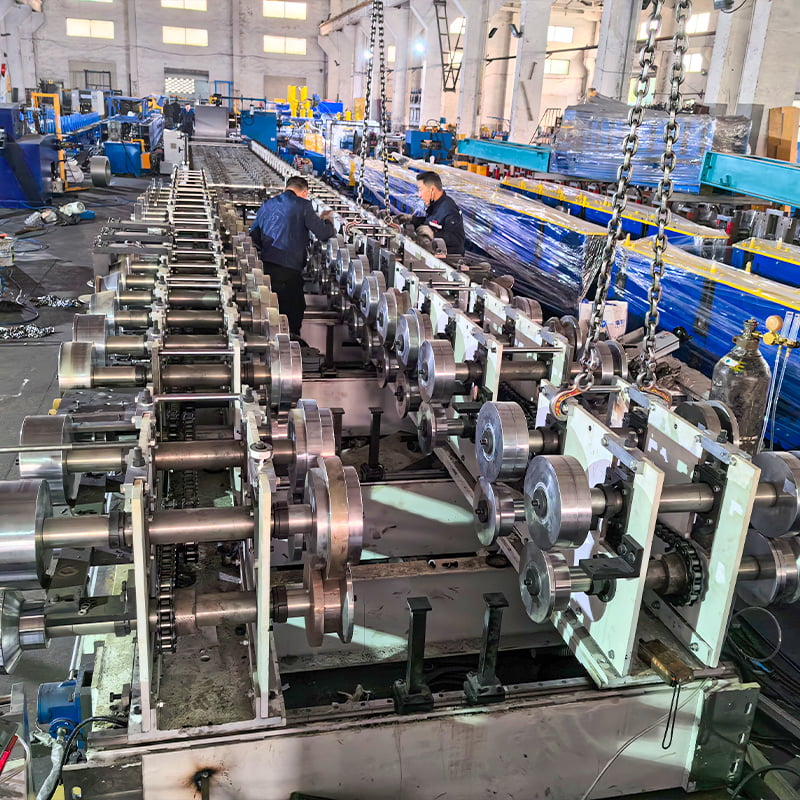
Types of Metal Roof Cladding
Choosing the right type of metal cladding for your roof is vital for achieving both functional and aesthetic goals. Each metal type offers unique benefits and trade-offs, so let’s break down some of the most popular options:
Corrugated Iron Sheets
Corrugated iron sheets are one of the most recognizable and commonly used metal cladding options. Their wavy pattern increases strength, making them a durable and cost-effective choice for roofing.
| Corrugated Iron Sheet Types | Description |
|---|---|
| Galvanized Corrugated Sheets | Coated with zinc to prevent corrosion, making them ideal for coastal environments. |
| Colorbond Corrugated Sheets | Available in various colors, offering both durability and a visually appealing finish. |
| Stainless Steel Corrugated Sheets | More expensive but highly resistant to corrosion, especially in acidic or salty environments. |
Standing Seam Metal Panels
Standing seam panels are known for their sleek, modern appearance and exceptional weatherproofing capabilities. The seams of the panels are raised above the surface, preventing water from seeping in.
| Standing Seam Panel Types | Description |
|---|---|
| Aluminum Standing Seam | Lightweight and resistant to rust, suitable for areas with heavy rain or snow. |
| Copper Standing Seam | Offers a stunning aesthetic, developing a natural patina over time. |
| Steel Standing Seam | Coated with zinc or aluminum to prevent rust, offering a sturdy yet cost-effective option. |
Metal Shingles
For homeowners seeking the aesthetic of traditional shingles with the durability of metal, metal shingles are an excellent choice. They mimic the look of asphalt or wood while offering enhanced longevity.
| Metal Shingle Types | Description |
|---|---|
| Aluminum Shingles | Lightweight and resistant to corrosion, ideal for residential roofs. |
| Steel Shingles | Strong and durable, typically coated for additional protection against rust. |
| Copper Shingles | Offer a unique, luxurious appearance and last for decades. |
Zinc Cladding
Zinc is a self-healing material, meaning that scratches or blemishes will naturally repair themselves over time. This makes it a long-lasting and low-maintenance option for roofing.
| Zinc Cladding Types | Description |
|---|---|
| Natural Zinc Cladding | Develops a matte gray patina that protects the metal from corrosion. |
| Pre-patinated Zinc | Pre-treated to mimic the look of weathered zinc right from the installation. |
Metal Roof Tiles
Metal tiles are designed to resemble traditional clay or slate tiles but offer the longevity and strength of metal.
| Metal Tile Types | Description |
|---|---|
| Aluminum Roof Tiles | Lightweight and ideal for homes in hurricane-prone areas. |
| Steel Roof Tiles | Durable and affordable, available in various finishes. |
| Copper Roof Tiles | Expensive but highly durable, adding a sophisticated touch to any roof. |
Working Process of Metal Roof Cladding
The process of installing metal roof cladding involves several stages, from preparation to final installation. Here’s an overview of the typical workflow:
1. Planning and Material Selection
The first step is determining the best metal cladding material for your specific needs. Consider factors like budget, climate, and aesthetic preferences when making your selection.
2. Preparing the Roof Surface
Before installing the cladding, the roof surface needs to be prepared. This may involve cleaning the surface, repairing any existing damage, and ensuring proper insulation and waterproofing are in place.
3. Measuring and Cutting
Precision is key when it comes to installing metal cladding. Sheets or panels must be measured and cut accurately to fit the roof dimensions. This is done using specialized cutting tools and machines designed for different types of metal.
4. Fastening the Cladding
The metal sheets or panels are fastened to the roof using screws or clips. Proper fastening ensures that the cladding will remain secure and weather-tight, even in extreme conditions.
5. Sealing and Finishing
Finally, seams and joints are sealed to prevent leaks. Any edges or corners are covered with trim pieces to give the roof a finished look. If applicable, a final coating may be applied for additional protection and aesthetic appeal.
Key Components of Metal Roof Cladding
To ensure the durability and efficiency of metal roof cladding, various components work together. Below is a breakdown of the key elements involved in a typical metal cladding system:
| Component | Function |
|---|---|
| Cladding Sheets | Protects the roof from environmental factors (rain, snow, etc.). |
| Fasteners | Secures the cladding to the roof structure, ensuring stability. |
| Underlayment | Provides an extra layer of protection against moisture. |
| Seams | Connects panels together, ensuring water-tightness. |
| Trim Pieces | Covers the edges and corners, giving a polished appearance. |
| Insulation | Improves energy efficiency and reduces noise. |
| Vapor Barrier | Prevents moisture from penetrating the roofing structure. |
-
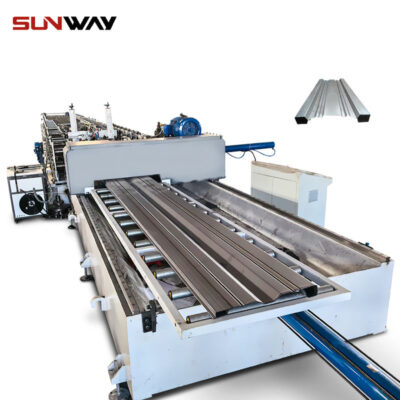 ক্যারেজ বোর্ড রোল ফর্মিং মেশিন
ক্যারেজ বোর্ড রোল ফর্মিং মেশিন -
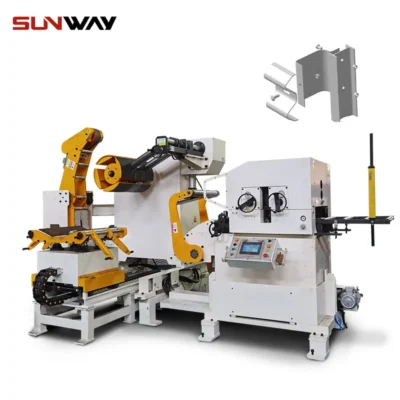 Highway Guardrail End Terminal Forming Machine
Highway Guardrail End Terminal Forming Machine -
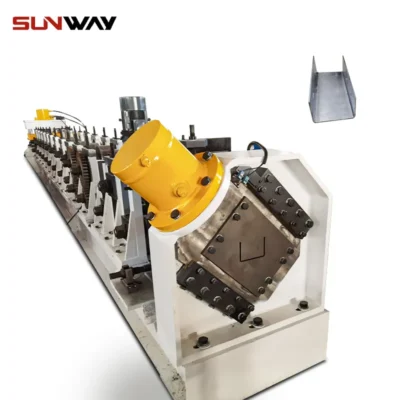 Highway U/C Post Roll Forming Machine
Highway U/C Post Roll Forming Machine -
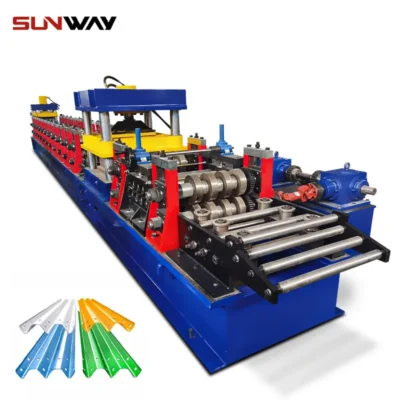 2 Waves Highway Guardrail Roll Forming Machine
2 Waves Highway Guardrail Roll Forming Machine -
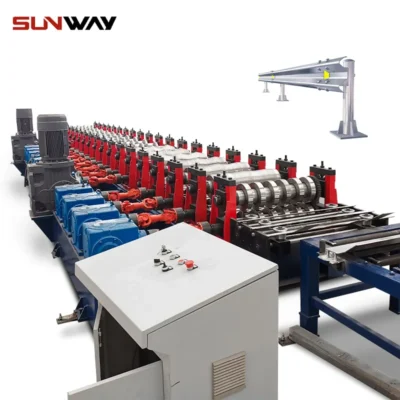 3 Waves Highway Guardrail Roll Forming Machine
3 Waves Highway Guardrail Roll Forming Machine -
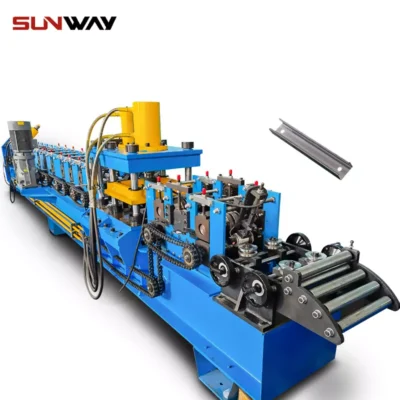 সি সেকশন ব্রেসিং ওমেগা স্টোরেজ র্যাক খাড়া পোস্ট রোল ফর্মিং মেশিন
সি সেকশন ব্রেসিং ওমেগা স্টোরেজ র্যাক খাড়া পোস্ট রোল ফর্মিং মেশিন -
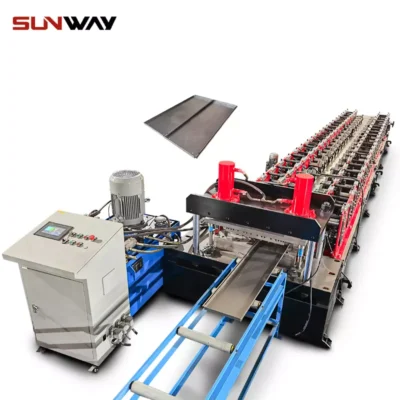 স্টিল বক্স প্লেট মেকিং রোল ফর্মিং মেশিন
স্টিল বক্স প্লেট মেকিং রোল ফর্মিং মেশিন -
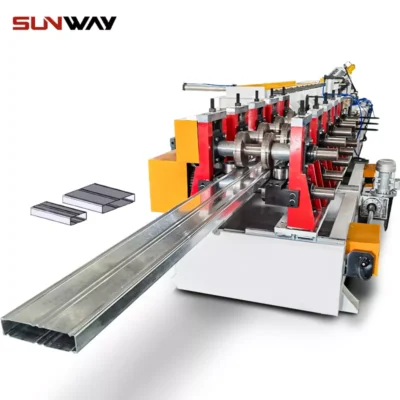 বক্স মরীচি স্টীল রোল শেল্ফ কলাম জন্য মেশিন গঠন
বক্স মরীচি স্টীল রোল শেল্ফ কলাম জন্য মেশিন গঠন -
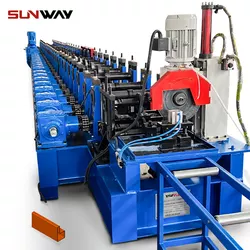 প্যালেট র্যাকিং স্টেপ বিম পি বিম রোল তৈরির মেশিন
প্যালেট র্যাকিং স্টেপ বিম পি বিম রোল তৈরির মেশিন
Machine Efficiency in Metal Roof Cladding উৎপাদন
Metal cladding sheets are typically produced using roll-forming machines, which can process different types of metal into the desired profiles. The efficiency of these machines impacts production speed and overall quality.
| Machine Parameters | Efficiency Details |
|---|---|
| Speed | Varies from 10 to 60 meters per minute depending on the machine model. |
| Power Consumption | Typically between 5 and 15 kW per hour, depending on the material. |
| Cycle Time | Ranges from 2 to 5 seconds per panel. |
| Capacity | Up to 5000 square meters of cladding can be produced per day. |
Customized Mechanical Parameters for Metal Roof Cladding
When purchasing roll-forming machines, it’s important to consider the customizable options to fit the specific needs of the project.
| Customizable Parameter | Description |
|---|---|
| Sheet Thickness | Adjustable between 0.3mm to 1.2mm depending on material. |
| Panel Length | Can be customized for longer or shorter roof spans. |
| Width Range | Options typically range from 600mm to 1200mm. |
| Profile Type | Various profiles like corrugated, standing seam, or flat. |
| Color Coating | Available in different finishes, including matte and glossy. |
Applications of Metal Roof Cladding
Metal roof cladding is used in a wide range of construction applications, from residential homes to commercial buildings and even industrial facilities.
| আবেদন | Description |
|---|---|
| Residential Roofing | Popular for homes due to its aesthetic appeal and durability. |
| Commercial Buildings | Often used for offices, retail stores, and shopping malls. |
| Industrial Facilities | Chosen for its strength and ability to withstand harsh conditions. |
| Agricultural Buildings | Used for barns, sheds, and other structures where weather resistance is crucial. |
| Public Institutions | Schools, libraries, and government buildings often use metal cladding for long-term durability. |
Installation, Operation, and Maintenance of Metal Roof Cladding
Proper installation, operation, and maintenance of metal roof cladding ensure that your roof will perform optimally and last for decades.
| Process | Description |
|---|---|
| Installation | Involves planning, measuring, cutting, and fastening cladding panels. Proper installation is key to preventing leaks and ensuring longevity. |
| Operation | Once installed, the cladding protects the roof from environmental factors like rain, snow, and sun. |
| Maintenance |
Metal cladding requires little maintenance, but regular checks for loose fasteners, corrosion, and sealing issues are recommended.|
Supplier and Price Range Details for Metal Roof Cladding
Finding the right supplier is essential for obtaining high-quality metal roof cladding at a reasonable price. Below is a list of some popular suppliers and price ranges for different types of metal cladding:
| Supplier | Material Offered | Price Range (Per Square Meter) |
|---|---|---|
| ABC Metal Roofing | Galvanized steel, Aluminum | $10 – $30 |
| Kingspan Group | Steel, Zinc, Aluminum | $15 – $35 |
| Metal Sales | Copper, Aluminum | $20 – $45 |
| McElroy Metal | Steel, Zinc | $12 – $28 |
How to Choose the Right Metal Roof Cladding Supplier
Selecting the right supplier for metal roof cladding requires careful consideration of several factors. Here’s what to keep in mind:
| Consideration | Description |
|---|---|
| Material Quality | Ensure that the supplier offers high-quality, durable metals that meet industry standards. |
| Reputation | Look for suppliers with good reviews and a history of providing reliable products. |
| Customization Options | Some suppliers offer more customization options than others, which can be important for specific projects. |
| Pricing | Compare prices across suppliers to find the best deal without sacrificing quality. |
| Lead Time | Consider how quickly the supplier can deliver the materials, especially for large projects. |
Advantages and Disadvantages of Metal Roof Cladding
When choosing metal roof cladding, it’s essential to weigh the pros and cons to determine if it’s the right choice for your project.
| Advantages | Disadvantages |
|---|---|
| Durability | Can last up to 50 years with proper maintenance. |
| Energy Efficiency | Reflects heat, reducing cooling costs. |
| Aesthetic Flexibility | Available in a variety of colors and finishes. |
| Fire Resistance | Non-combustible, providing extra safety. |
| Initial Cost | Higher upfront costs compared to other materials. |
| Noise | Can be noisier during heavy rain unless proper insulation is used. |
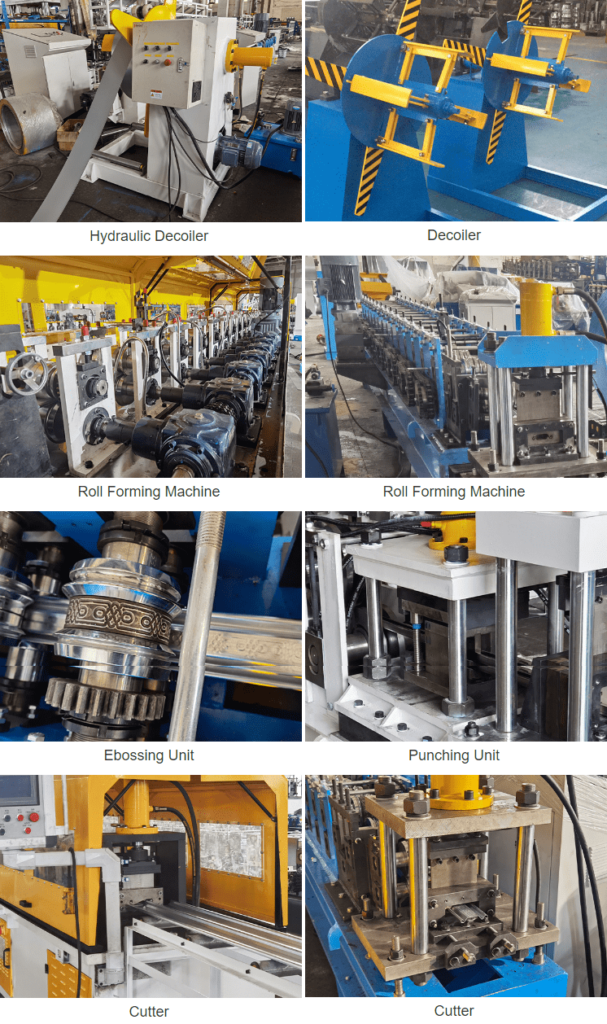
FAQ
| Question | Answer |
|---|---|
| How long does metal roof cladding last? | Metal roof cladding can last 40 to 70 years, depending on the material used. |
| Is metal roof cladding noisy? | Without proper insulation, metal roofs can be noisy during rain or hail, but this can be mitigated with soundproofing techniques. |
| Can metal roof cladding withstand extreme weather? | Yes, metal roofs are highly resistant to wind, hail, and heavy rain, making them ideal for extreme climates. |
| Is metal roof cladding energy efficient? | Metal roofs are highly energy-efficient due to their reflective properties, which can reduce cooling costs by up to 25%. |
| What are the maintenance requirements? | Metal roofs require minimal maintenance, but periodic checks for loose fasteners and corrosion are recommended. |
উপসংহার
Metal roof cladding offers a robust, versatile, and aesthetically pleasing solution for modern buildings. With various types of metal cladding available, each with its own set of advantages, the choice ultimately depends on your specific needs, preferences, and budget. Whether you’re installing cladding on a residential home or a commercial building, understanding the types, installation process, and maintenance requirements will help you make an informed decision for your next project.
